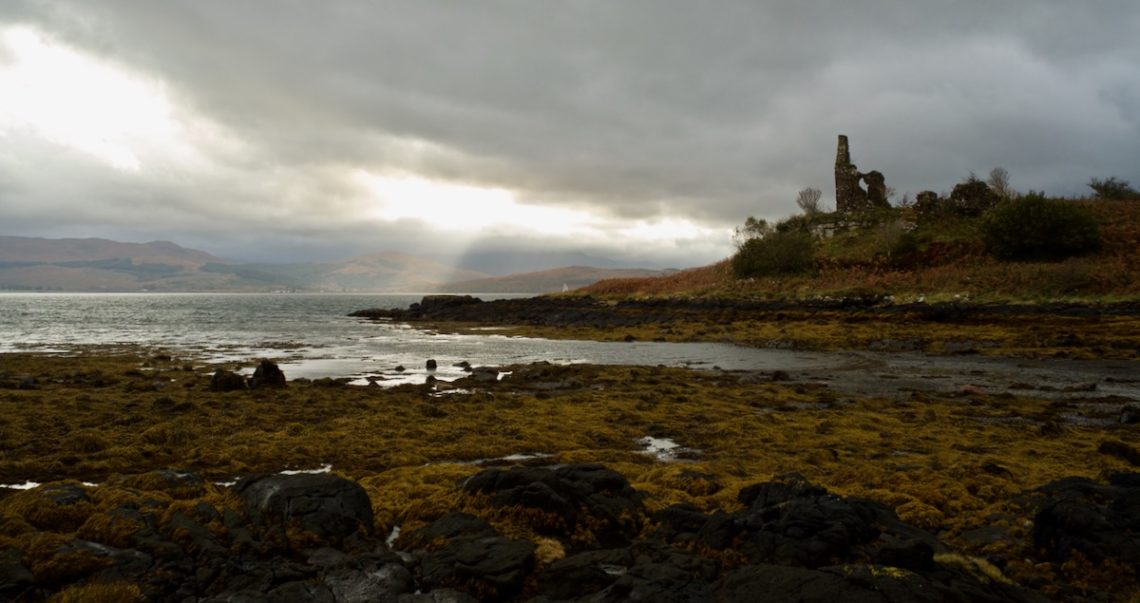
Morvern: black rocks and white water
It was a road we’d not driven on before, one that follows the south-west shore of Morvern from Lochaline all the way to Drimnin, with passing places and sudden bends so that you rarely get out of third gear. But a slow crawl was the only way to appreciate the views, with the sun occasionally piercing the cloud and spilling shafts of light into the Sound of Mull. Showers rattled through, but here and there the sunlight glanced sideways off the hills, kindling the birches into tongues of yellow flame.
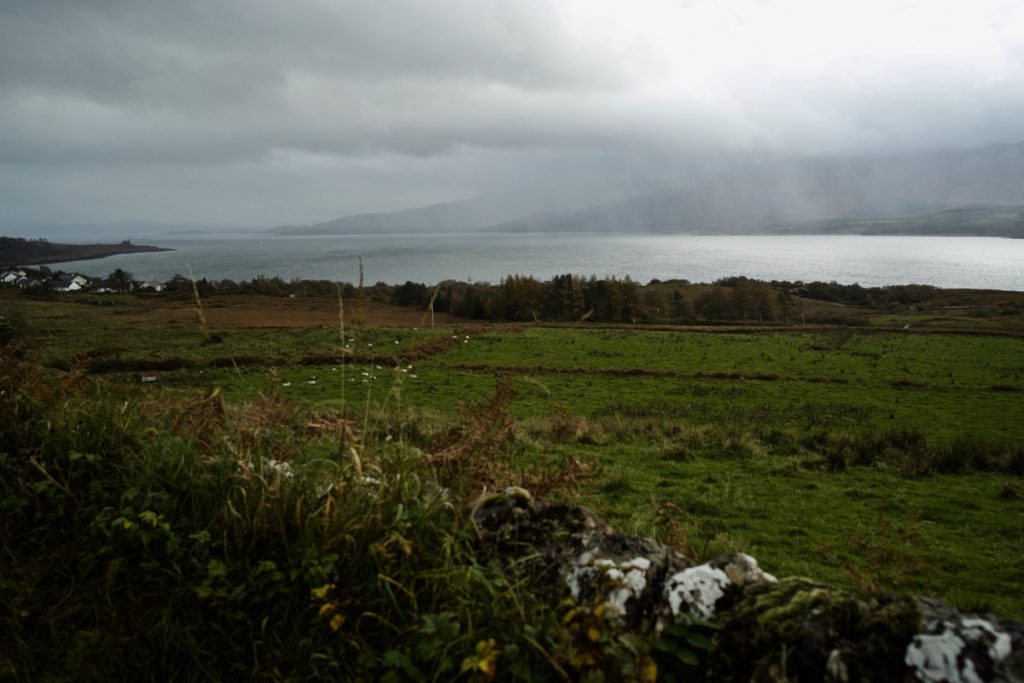
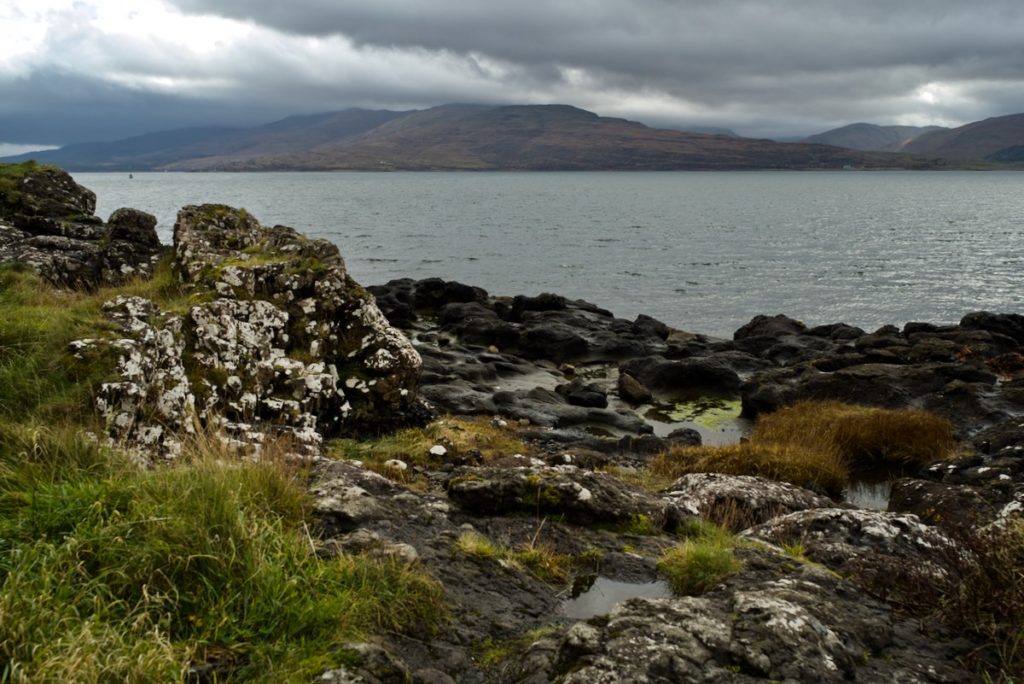
We stopped repeatedly to get out and admire the wide sweep of sea and islands, and to breathe in the damp decaying scents of autumn. On the ground, in a plantation of spruce and pine, tiny brown balls of fungi clustered on rotting wood, and spectre-white fingers had thrust themselves up through the moss. It’s about now that the woods seem to regain their perpetual half-light, and become a sylvan ‘otherworld’; you imagine unseen, wide-eyed creatures inhabiting the gloom.
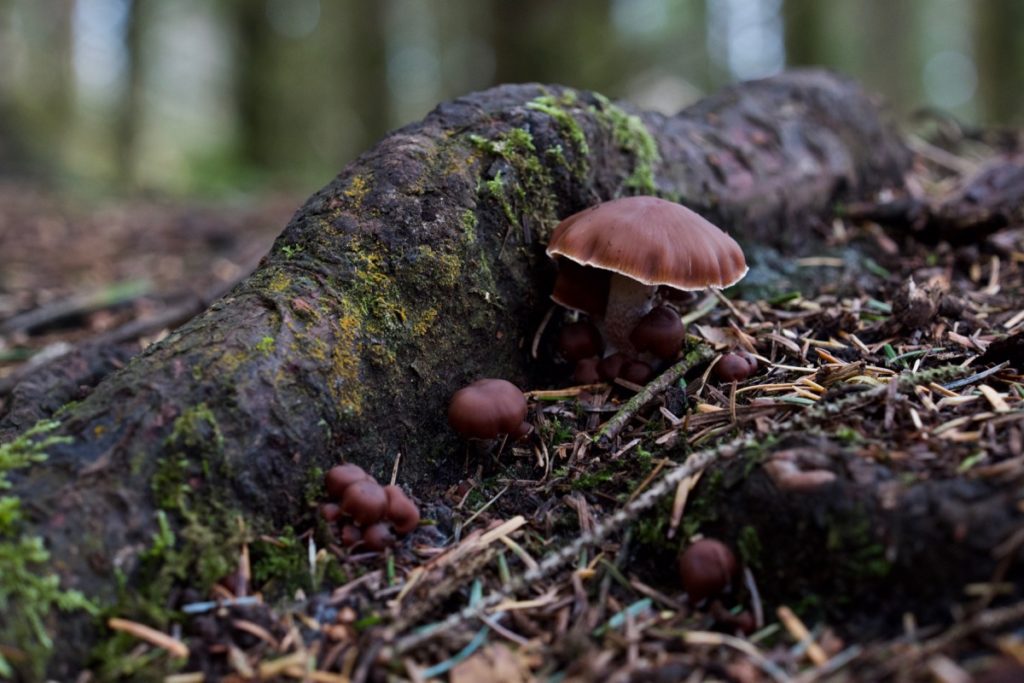
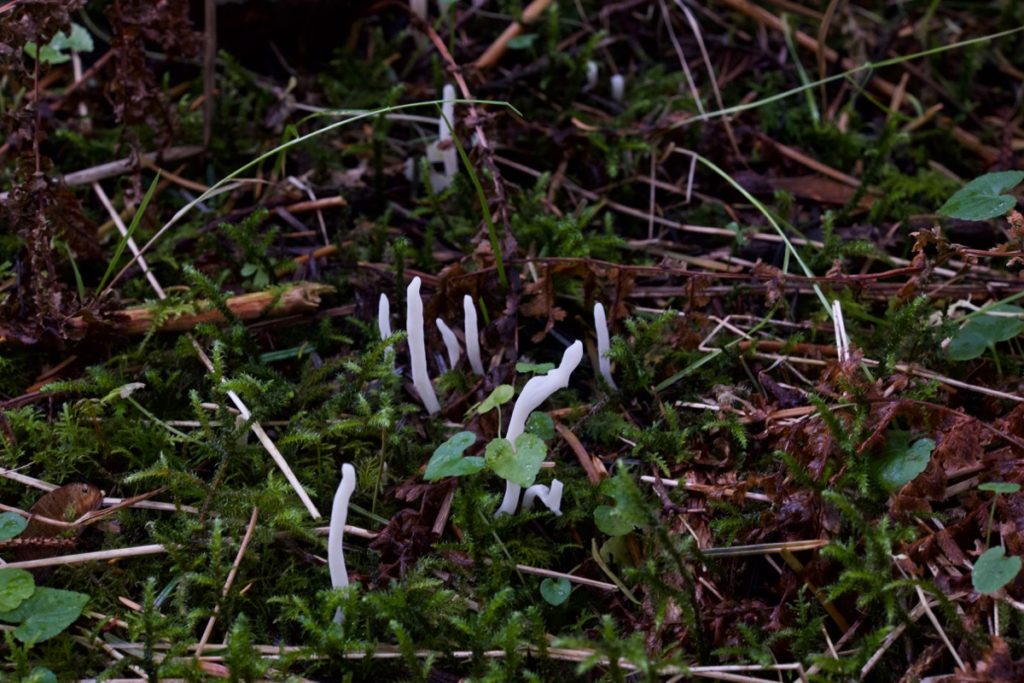
From a far field came the shrill chatter of a jay; we’ve been hearing these birds a lot recently, always before catching sight of them, dipping rhythmically in flight from one tree to the next. They are after the acorns, and there seem to be plenty around. Even though I recognise their call, jays still seem to catch me out with their sudden shriek, living up to their old Gaelic name of Screachag choille, ’the screamer of the woods’.
At a small car park – possibly the only one along this road – we got out and walked down to a geological feature called Clach na Criche. Apparently, this broken ‘wall’ of pale-coloured rock, about 20 or 30 feet high, was created by lava flowing from a super-volcano some 60 million years ago. Since then, the softer surrounding rocks have been eroded away (by the waves as well as the weather, as sea levels rose and fell), leaving an isolated wall with an enigmatic-looking hole in it.
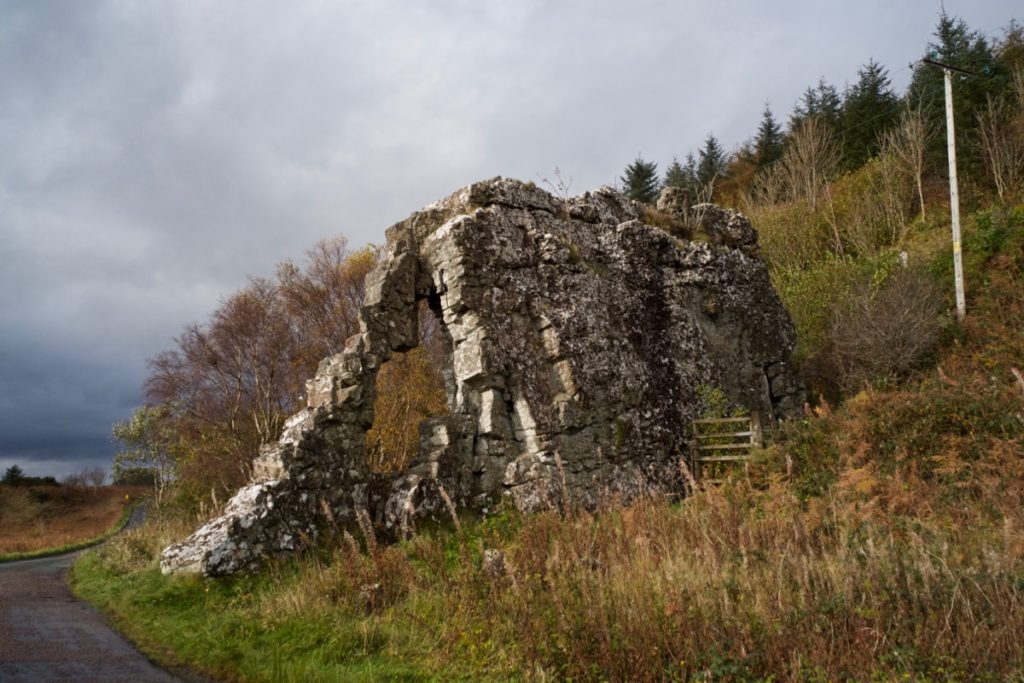
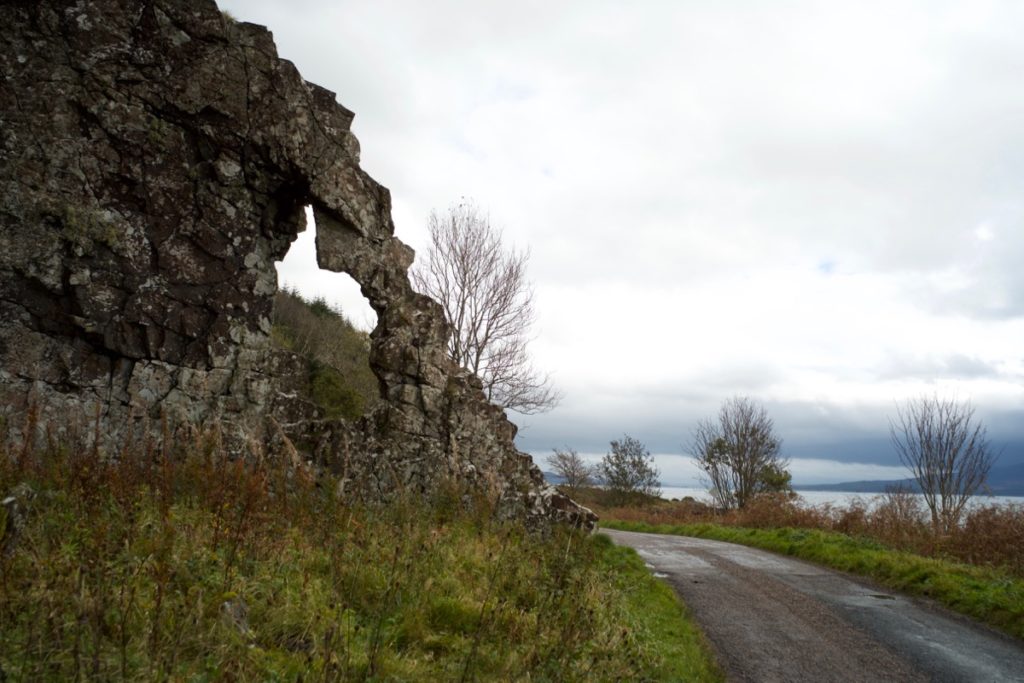
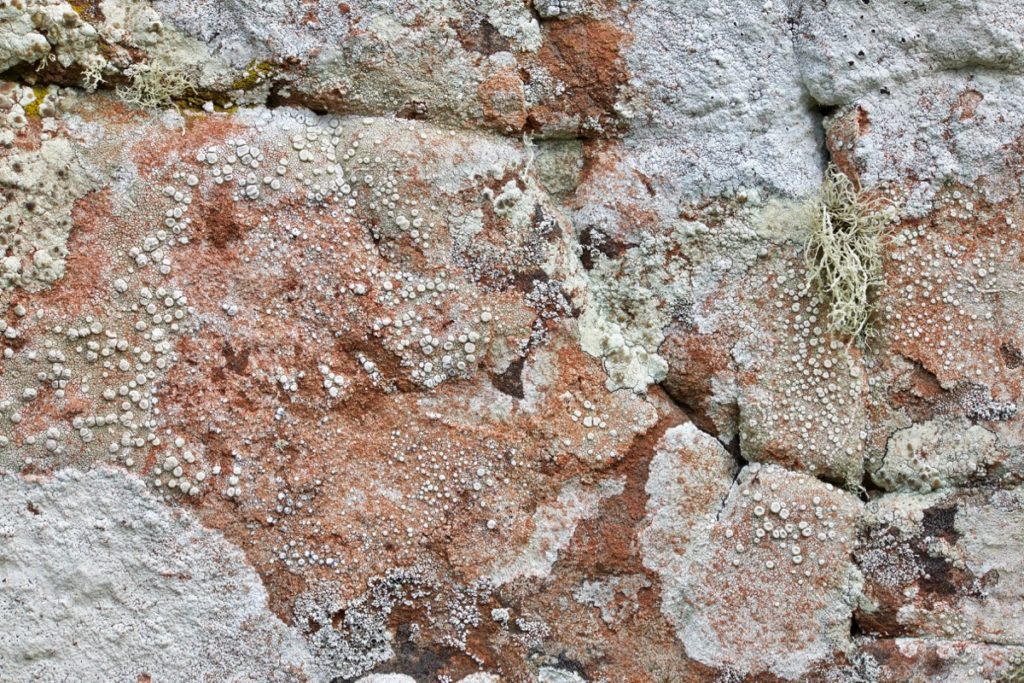
Lichens on Clach na Criche
Clach na Criche means ‘boundary stone’, and folklore claims that this feature once marked the boundary between Pictish and Gaelic territory (and much later, the boundary between parishes). Funeral processions would traditionally stop and rest here as they travelled from Lochaline to Drimnin, at the far end of the peninsula. A more modern name for the rock is ‘the Wishing Stone’, and visitors indulged in a ritual that was said to grant a wish: you had to hold some water from a nearby spring in your mouth while climbing through the hole three times, without swallowing it or touching the sides.
On the shore side of the road, with the tide well out, the black rocks were splashed yellow with seaweed and pitted with abandoned pools of seawater. Against the skyline, the stark profile of a ruin caught our eye: the gable-end of a tower house, rising from a low promontory that was surrounded on three sides by sea. Caisteal nan Con – yet another Castle of the Dogs! – built around 1670, on the site of an Iron Age fort. Canmore says: ‘It appears to have been a three-storeyed hall house rather than a defensive tower, built, it is said, by Allan Maclean, tacksman of Killundine.’
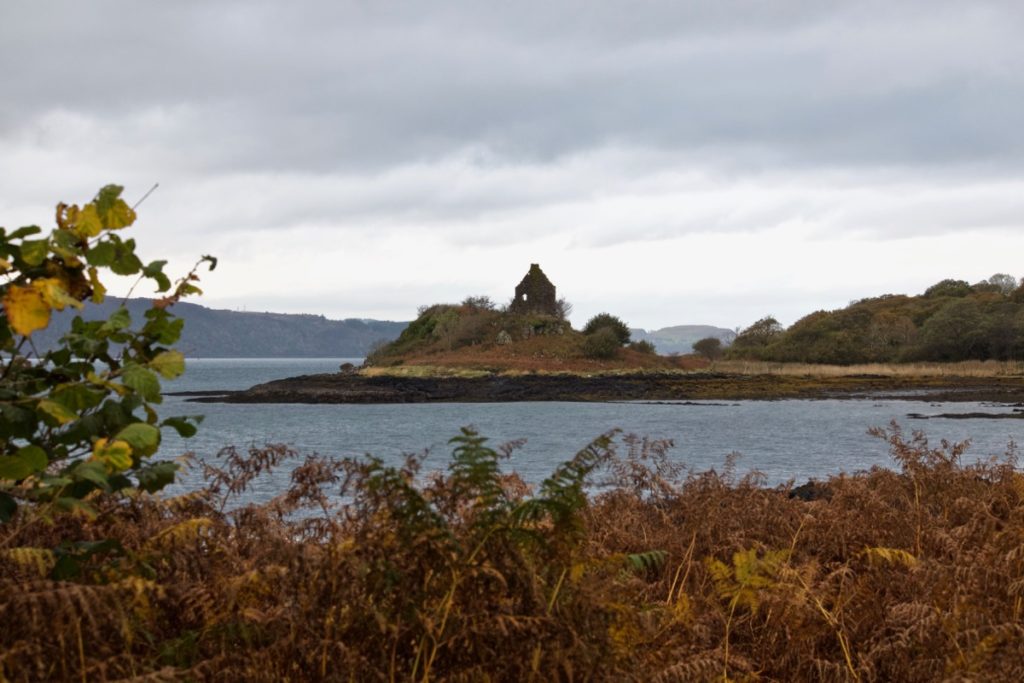
Looking at the surveys made of this site over the years (recorded on Canmore), the place was rectangular in plan and built of rubble masonry, re-using the stonework of the prehistoric fort. Fragments of a stair tower survive near the entrance on the west wall, and the living quarters were at the south end, with a fireplace on each floor. Referring to Mary Miers’ The Western Seaboard, an Illustrated Architectural Guide, Canmore adds: ‘The building is believed to have been abandoned soon after a government man-of-war attacked Jacobite rebels garrisoned here in 1719.’
We looked at it and assessed our chances. How hard could it be to get to, especially with the tide out? Our first line of attack was from the north, across a field with an interesting grove of beech trees in the middle, stone-walled all round, and then through a piece of woodland that looked innocent enough but turned out to be an impassable swamp. Back on the road, we walked south for a few hundred yards and took a more direct approach, plunging through a forest of reeds on the foreshore, then picking and slithering our way across rocks slick with seaweed and hummocks of marshy grass.
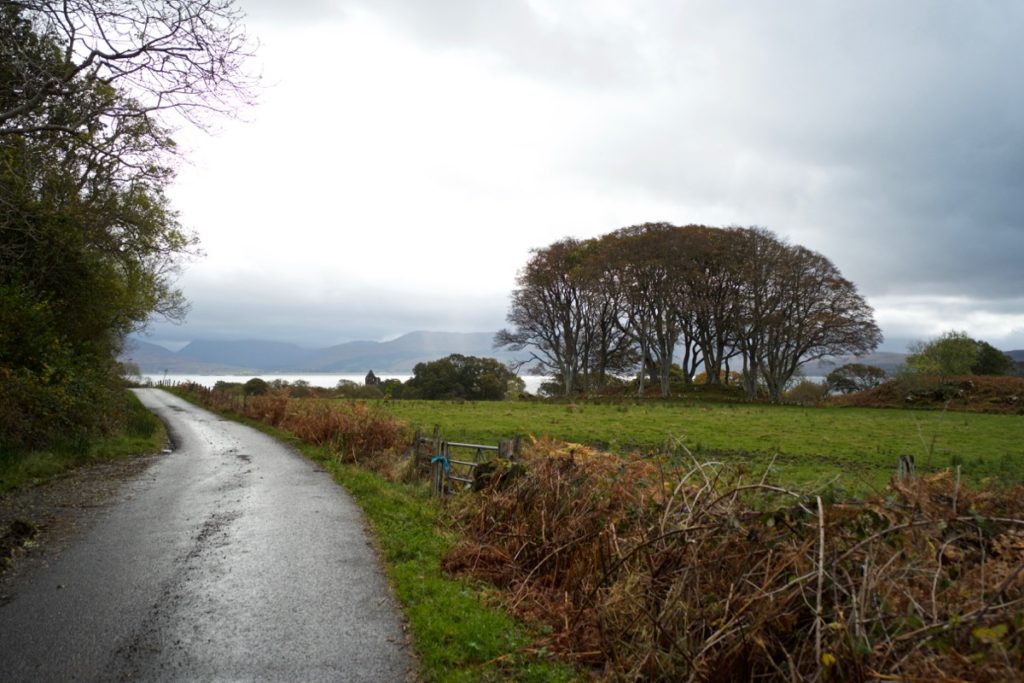
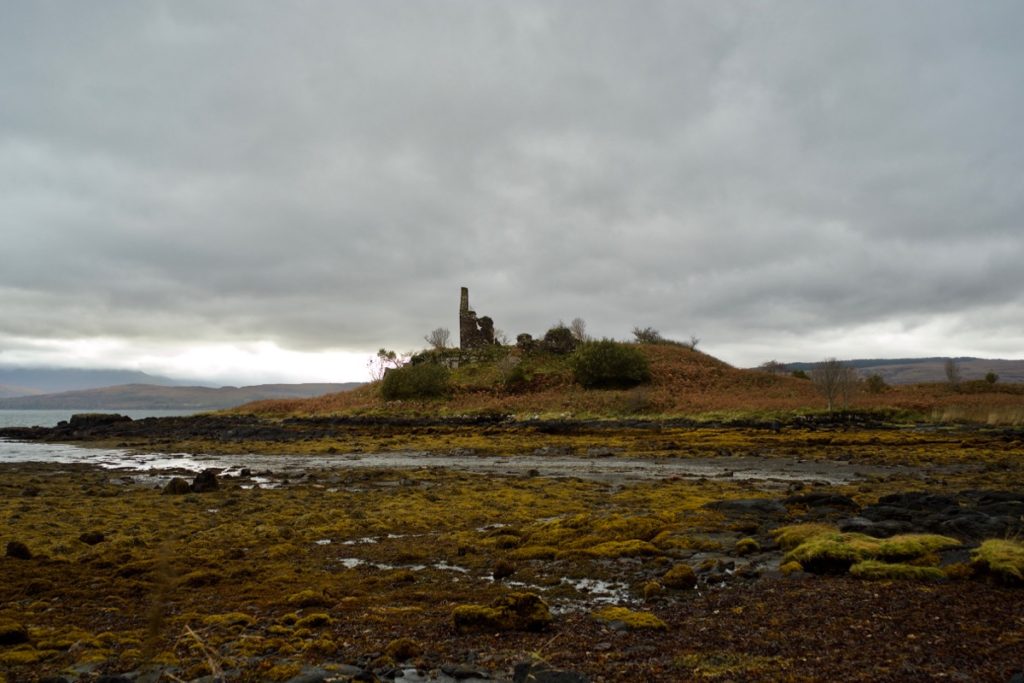
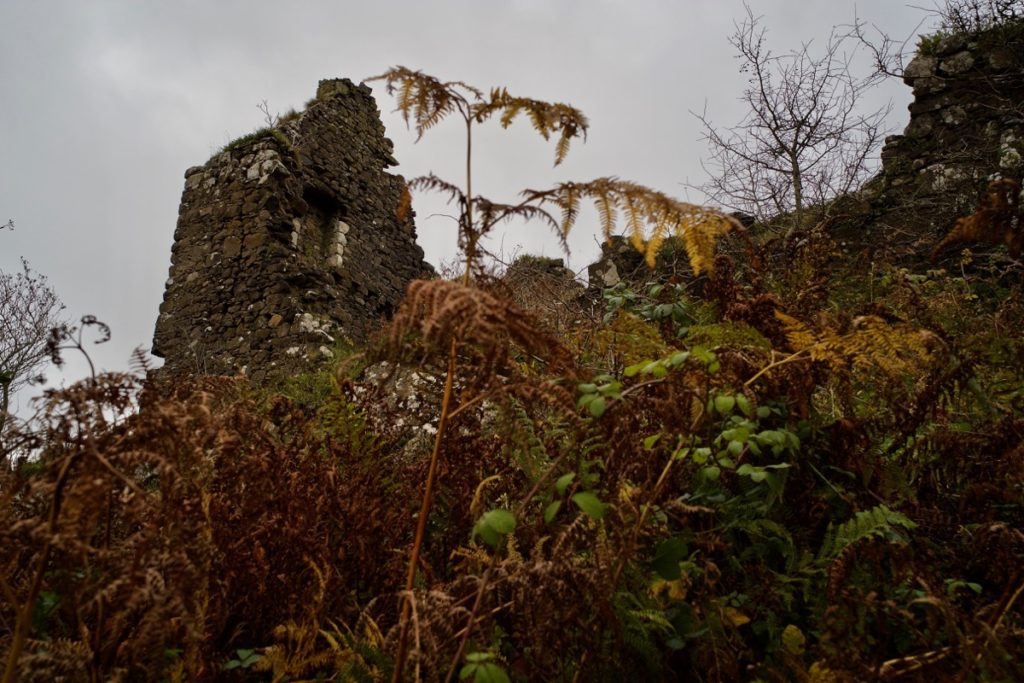
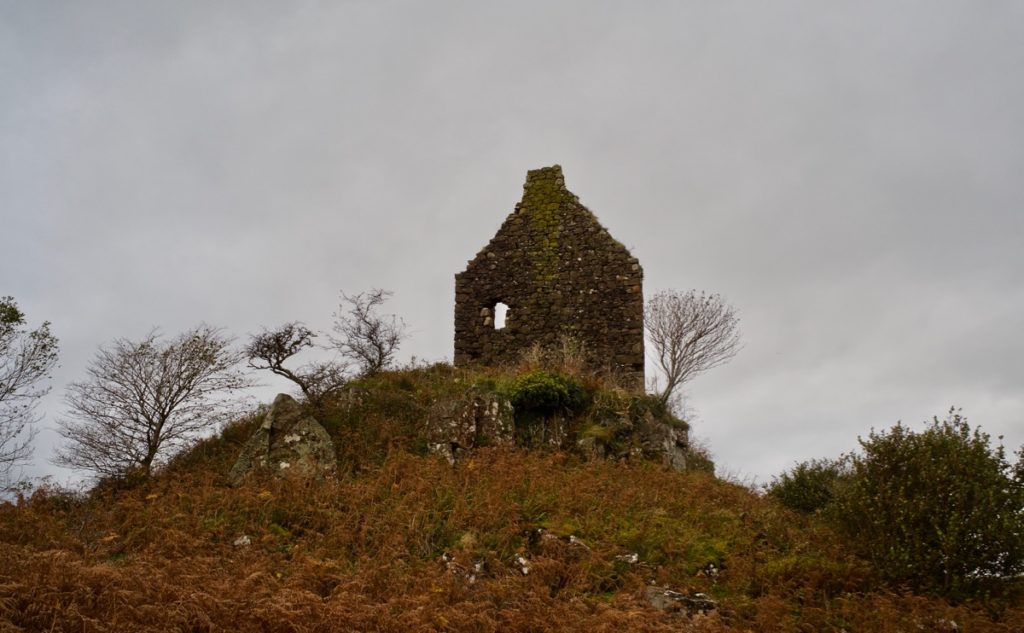
Bracken – why is there always bracken? – covering an awkward tumble of big boulders stopped us from tackling the promontory head-on: you just couldn’t see where you were going. Colin found a ‘path’ (seriously, I couldn’t see it) round the side, and we were nearing the southernmost tip, with the ruin looking just as inaccessible as before, when we heard a distinct sound, something between a huff and a sneeze, from the rocks at the water’s edge. We both froze, because we knew what it was.
Three otters, as dark as the rocks they were on. What we’d heard was an alarm call. The sight of them all on land was momentary, because two immediately writhed and slid away into the water, rearing their heads to stare in our direction. But a third, which looked like a youngster from its more ruffed-up fur, stayed on the rocks. Twisting its head about, it sniffed the water uncertainly and called repeatedly to its parents with a high-pitched squeak.
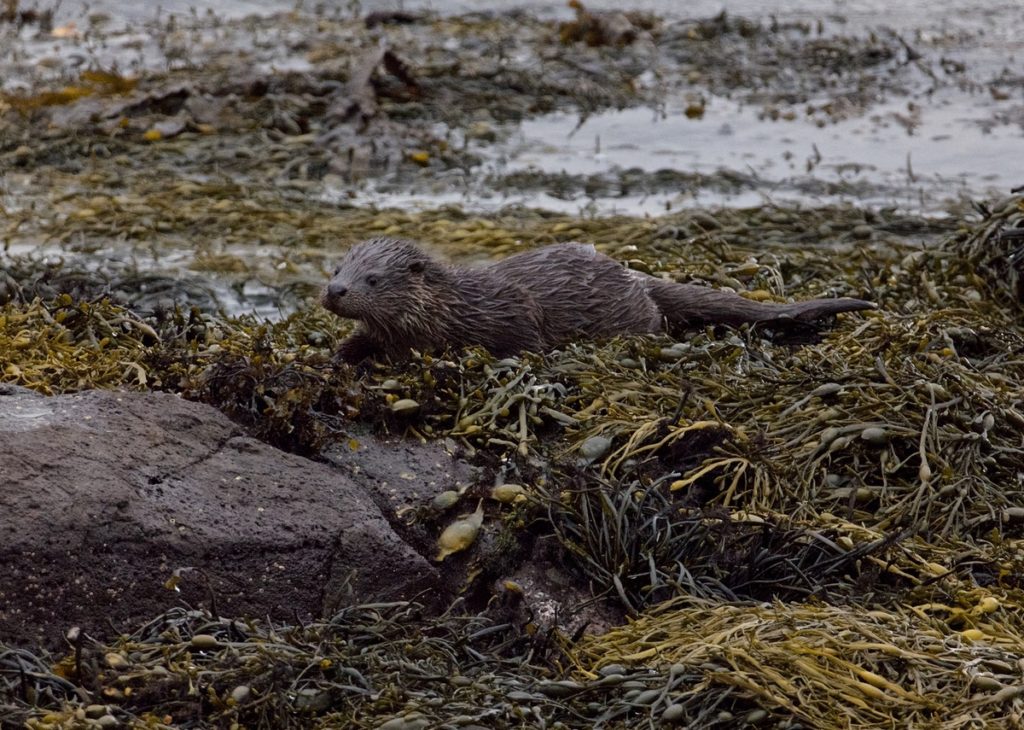
The youngster
The castle would have to wait. We couldn’t risk disturbing them further – they knew we were there, and we had nowhere to hide. Keeping our heads low, we turned and hurried – it was impossible to run – as soundlessly as we could, back down the long side of the promontory and out of sight, across the fraying strand of kelp and turf and boulders, and up into the fringe of trees. The parents wouldn’t go far, and the youngster was certainly not helpless, although in my mind I can still hear his plaintive whistle.
The afternoon was wearing on, and the overcast sky made it feel even later than it was. We drove back to Lochaline and from there up towards Strontian, along one of the loneliest and most remote stretches of road I’ve been on. The landscape was both sombre and brilliant: autumn burnishes the moorland grasses with copper and bronze, so that the entire hillside has a kind of luminescence, even in dim light.
Mist was giving way to light rain, with the tops already lost in cloud, and secreted in every fold of every hill was a vein of white water, tumbling from an unseen source and hurling itself down towards the valley floor. Here and there, close to a foaming spout, was a little cluster of cottages or a single farmhouse; one particular cottage, remote and fascinating, lay at the end of a miles-long track, so that I couldn’t help staring at it and wondering what it was like at night, with no neighbour in any direction, and red deer coming down to graze.
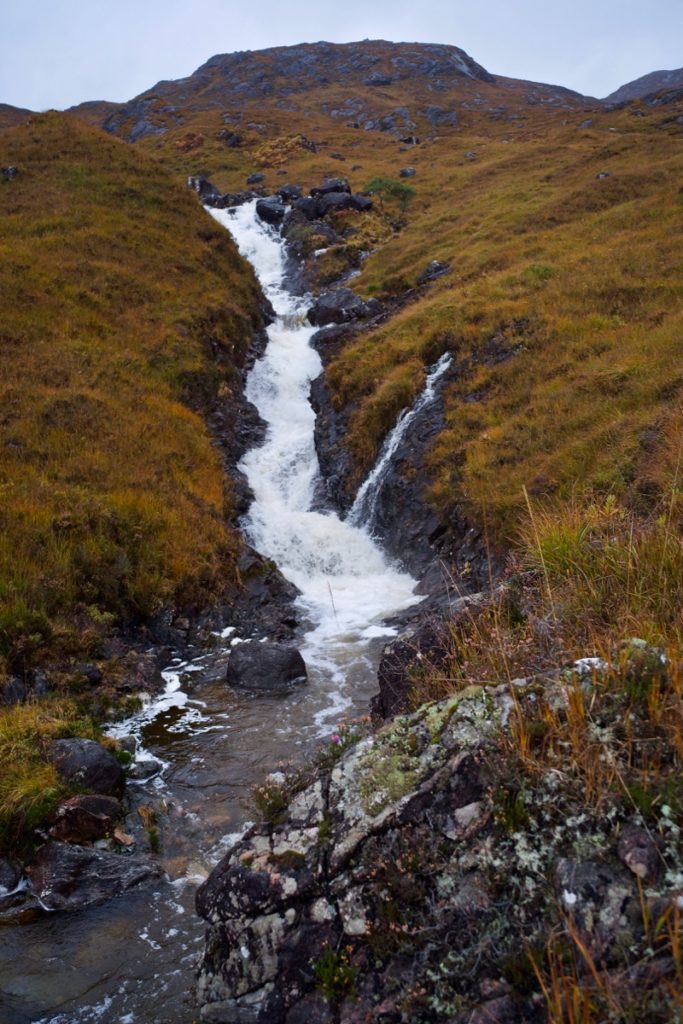
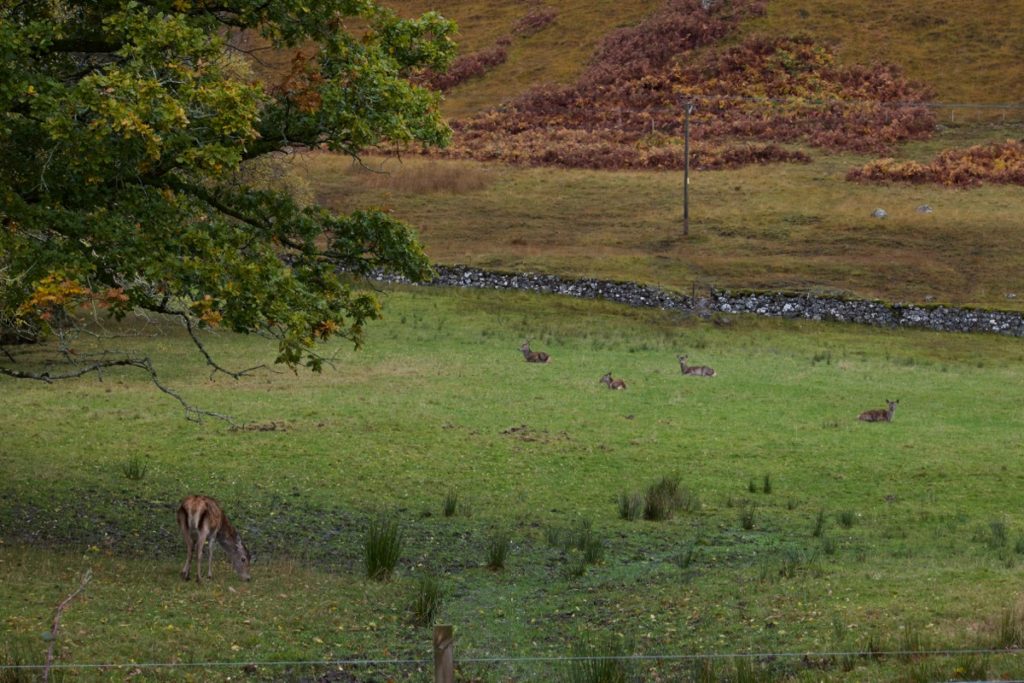
Red deer lounging
We skirted Loch Sunart, a long and beautiful sea-loch which is fated, or so it is said, never to have resident swans. An old story tells how a chieftain’s son fell in love with a poor crofter’s daughter but his mother, wishing instead for a noble marriage, went to a witch and begged for a spell to drive the lovers apart. The girl was transformed into a swan, but, knowing nothing of her fate, the chieftain’s son killed the bird with his bow and then died of remorse when she revealed her human form. Since then, swans have never lived on the loch.
Across Loch Linnhe on the Corran ferry and back to the ‘mainland’, or so it felt – Morvern is only a peninsula, but the alternative is a very long round trip by car. From a distance, the peaks and ridges of Glen Coe seemed to rise straight up from the Ballachulish bridge, which spans Loch Leven. I wonder how long it will be before they are white with snow.
Reference:
- Canmore: Caisteal nan Con, also known as Killundine Castle and Dun Gaul
- Canmore: Clach na Criche
- Am Baile
- Morvern tourist info
More Castles of the Dogs (or Black Dogs) can be found at Torinturk and Craignish
Images copyright Colin & Jo Woolf
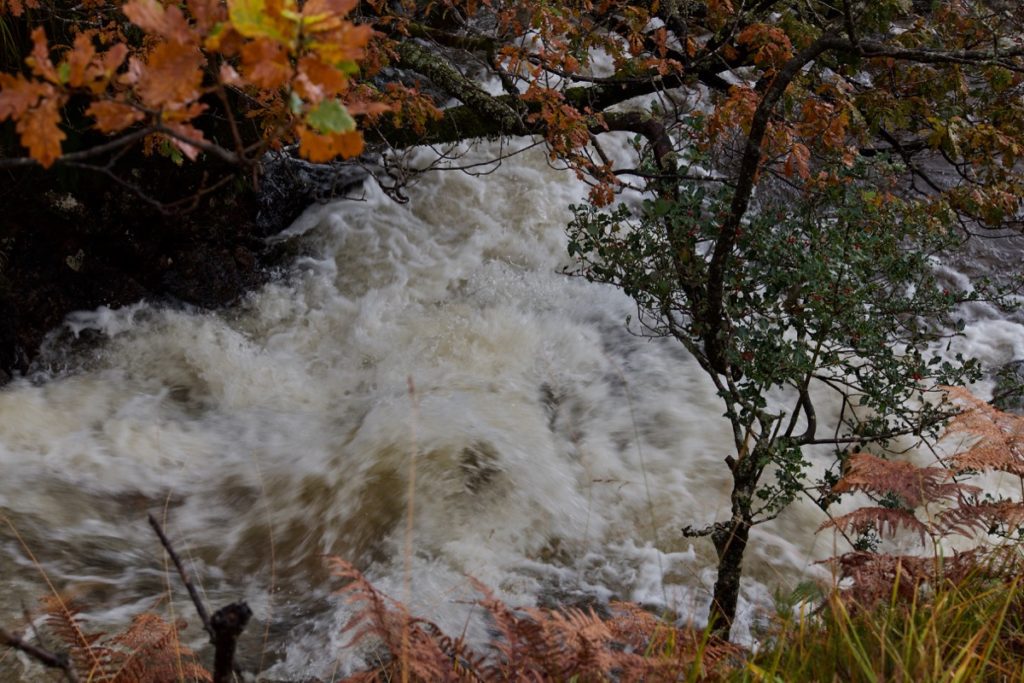



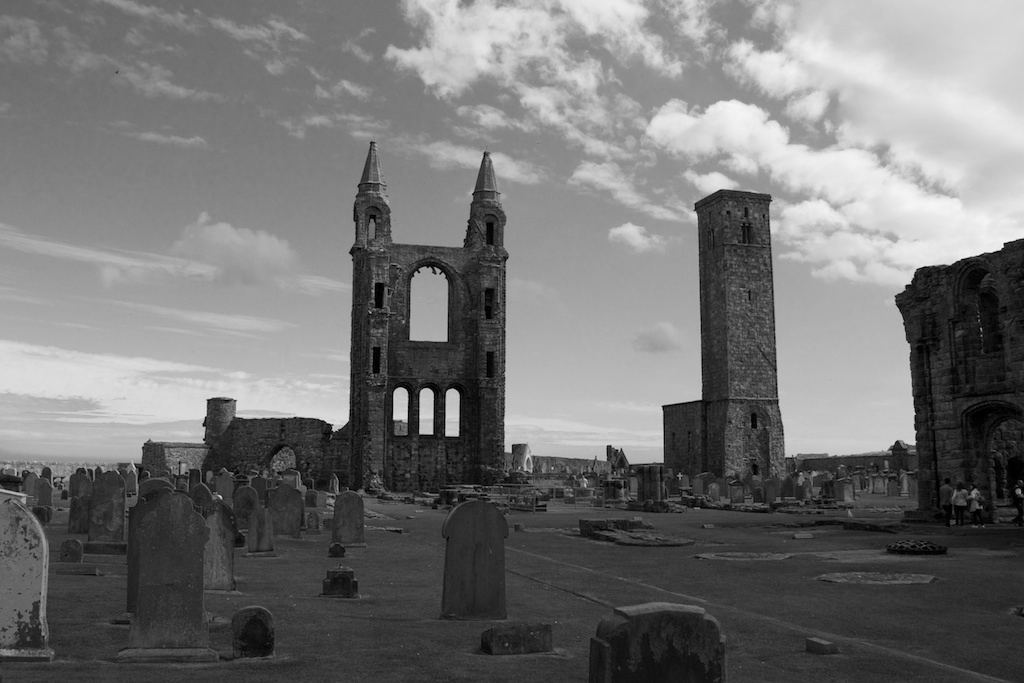
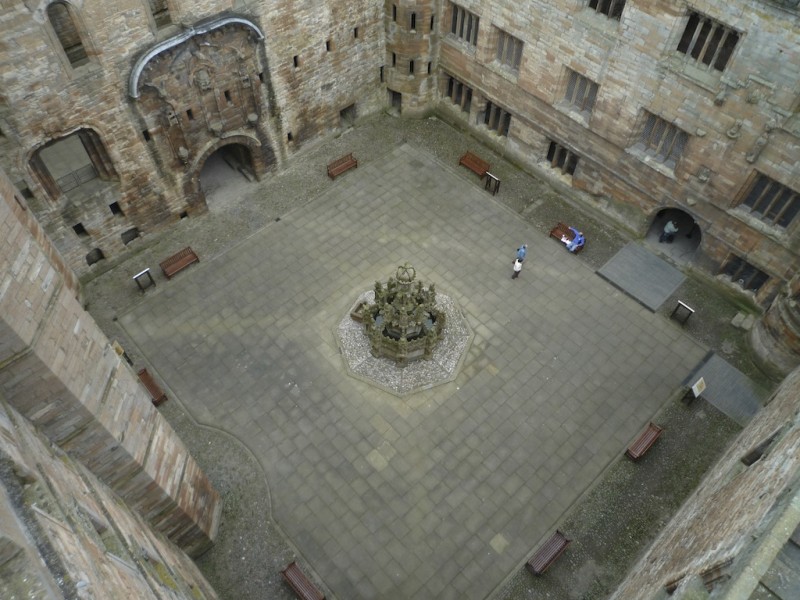
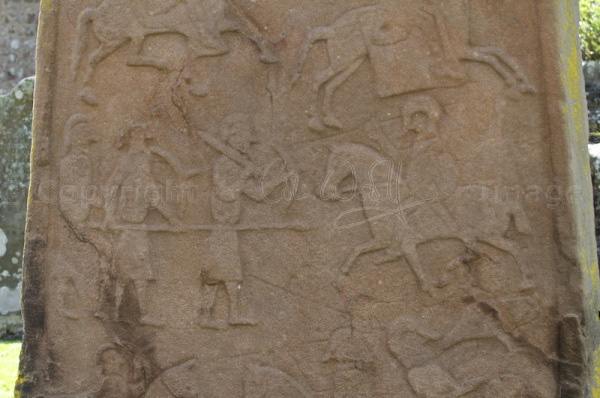
4 Comments
Finola
It’s hard to believe there’s a road you’ve never been on before – especially one as drenched in atmosphere as this one. But I want to know – did you go through the hole in Clach na Criche, and if not, why not? It looks like a tight squeeze.
Jo Woolf
Haha, I’m glad that there are still roads we’ve not driven on before! Yes, how beautiful is that scenery? I did clamber through the hole but I didn’t know about the spring-water-in-mouth condition, or that you had to do it three times! So I’m hoping my wish might still be valid!
Jean
Jo,
Lost about a year of reading your blog and now know how I will spend the upcoming chilly season catching up. Always a great read, fabulous photos, and a bit of new knowledge gained despite my grey temples and the adage wisdom comes with age. We have retired Jo and moved to the beautiful mountains of NC. Hope to follow in your footsteps and get out exploring. Thanks, from your American friends
Jo Woolf
Lovely to hear from you again, Jean! It sounds as if you’ve moved to a beautiful place, and I hope you’re enjoying yourselves in your new home. Enjoy your catch-up – I’ll be posting more here soon. Very best wishes, Jo